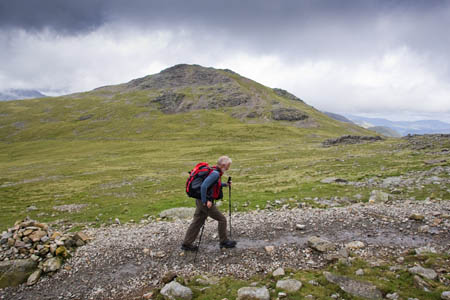
This septuagenarian, Sir Chris Bonington, keeps up a steady pace on his way up Scafell Pike
Everyone knows that walking is good for you. But how fast do you need to walk to get health benefits?
Research published this week in an American scientific journal suggests that, to get any real effect, walkers need to keep up a good pace. So how does this equate with, say, your average rambler or hillwalker?
The paper, published in the American Journal of Preventative Medicine, looked at the currently perceived level at which the advantages of walking kick in: 150 minutes’ worth of ‘moderate’ physical activity a week. This means and average of about 30 minutes a day, five times a week.
Pedometers have become commonplace among those puce, jogging-pants-clad walkers huffing and puffing alongside many of our roads, with various theories about how many steps you should take in a day. Well, the bad news for our power walkers is that they also need a stopwatch.
The research team found that only a pace of at least 100 footsteps a minute counts as moderate. Anything less is just not going to have the same health effect.
Admittedly, the tests, on 58 women and 39 men were carried out in laboratory conditions – subjects were put on a treadmill and their demands for oxygen measured. We at grough don’t recommend the use of treadmills or hamsters’ wheels when there is a perfectly adequate alternative available: the British countryside.
So, for those of us who only ever walk on canal towpaths, or perhaps live in Norfolk, the tests have meaning. The rest of us, who regularly tackle the bumpier bits of Britain or love nothing better than teetering on Crib Goch or Aonach Eagach, may need to adjust the findings a little.
It is, perhaps, pertinent that the study was based in San Diego, California, where fitness crazes are considered long in the tooth if they last to the end of the day in which they were conceived.
Hence, the fixation with pedometers. Lead investigator Dr Simon J. Marshall, of the School of Exercise and Nutritional Sciences, San Diego State University, said of the study: “We believe that these data support a general recommendation of walking at more than 100 steps per minute on level terrain to meet the minimum of the moderate-intensity guideline.
“Because health benefits can be achieved with bouts of exercise lasting at least 10 minutes, a useful starting point is to try and accumulate 1,000 steps in 10 minutes, before building up to 3,000 steps in 30 minutes.
“Individuals can monitor their progress using a simple pedometer and a wristwatch. The use of a single and simple pedometer-based guideline that is easy both to remember and measure may be more effective in a health communication strategy than the promotion of multiple guidelines and, therefore, messages.”
So, at the risk of spawning a generation of hillgoers with a pedometer in one hand and a stopwatch in the other, how does this recommendation square with your average rambler or hillwalker?
Let’s do the maths. A typical pace for an average sized man or woman is round about 60 double paces per 100m, as anyone who has struggled with micronavigation in the clag will no doubt recall.
So your regular rambler will take about 120 steps every 100m. To meet Dr Marshall’s pedometer pedantry, the walker needs to cover those 100m in 72 seconds, or 1.2 minutes. Sound familiar? Well, how about referring to Mr William W Naismith, renowned Victorian mountaineer who devised, in 1892, the golden rule for navigators: on level ground (or even on a San Diego treadmill), the average walker will cover one mile in 20 minutes. Converted metrically, that means – bingo! – your typical rambler will cover 100m in 1.2 minutes, walking at a very typical 5km/hour.
They say there’s nothing new in life! No adjustment necessary, unless you’re a fan of Tranter.
So, breathe easy, and carry on as before. No need to sprint: 5k will do nicely. And, don’t forget to add your minute per 10m ascended or, as we would refer to the need to increase the metabolic rate when undertaking moderate exercise, huff and puff up those damn hills.
Now, how do you measure calf burn?
The bones of Dr Marshall’s article can be seen on the website of the American Journal of Preventative Medicine.
dougie
19 March 2009I heard this on the radio today, and I was trying to do the calculations in my head (not a good idea in town traffic) but I did think to myself that this equates more or less to Naismith's Rule. There is nothing new under this Sun?